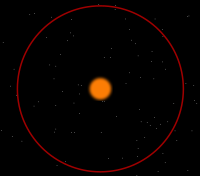Milankovitch cycles

- Graphic shows variations in five orbital elements:Axial tiltor obliquity (ε).Eccentricity(e).Longitude of perihelion(sin(ϖ)).Precession index (esin(ϖ))
- Precession index and obliquity controlinsolationat each latitude:Daily-average insolation at top of atmosphere on summer solstice () at 65° N
- Ocean sediment and Antarctic ice stratarecordancient sea levels and temperatures:Benthic forams(57 widespread locations)Vostok ice core (Antarctica)
- Vertical gray line shows present (2000 CE)
Milankovitch cyclesdescribe the collective effects of changes in the Earth's movements on itsclimateover thousands of years. The term was coined and named after the SerbiangeophysicistandastronomerMilutin Milanković.In the 1920s, he hypothesized that variations ineccentricity,axial tilt,andprecessioncombined to result in cyclical variations in the intra-annual and latitudinal distribution ofsolar radiationat the Earth's surface, and that thisorbital forcingstrongly influenced the Earth's climatic patterns.[1][2]
Earth movements
[edit]TheEarth's rotationaround itsaxis,and revolution around theSun,evolve over time due togravitational interactionswith other bodies in theSolar System.The variations are complex, but a few cycles are dominant.[3]
TheEarth's orbitvaries between nearly circular and mildlyelliptical(its eccentricity varies). When the orbit is more elongated, there is more variation in the distance between the Earth and the Sun, and in the amount ofsolar radiation,at different times in the year. In addition, the rotational tilt of the Earth (itsobliquity) changes slightly. A greater tilt makes the seasons more extreme. Finally, the direction in thefixed starspointed to by the Earth's axis changes (axial precession), while the Earth's elliptical orbit around the Sun rotates (apsidal precession). The combined effect of precession with eccentricity is that proximity to the Sun occurs during differentastronomical seasons.[4]
Milankovitch studied changes in these movements of the Earth, which alter the amount and location of solar radiation reaching the Earth. This is known assolar forcing(an example ofradiative forcing). Milankovitch emphasized the changes experienced at 65° north due to the great amount of land at that latitude. Land masses change temperature more quickly than oceans, because of the mixing of surface and deep water and the fact that soil has a lowervolumetric heat capacitythan water.[5]
Orbital eccentricity
[edit]The Earth's orbit approximates anellipse.Eccentricity measures the departure of this ellipse from circularity. The shape of the Earth's orbit varies between nearly circular (theoretically the eccentricity can hit zero) and mildly elliptical (highest eccentricity was 0.0679 in the last 250 million years).[6]Itsgeometricorlogarithmic meanis 0.0019. The major component of these variations occurs with a period of 405,000 years[7](eccentricity variation of ±0.012). Other components have 95,000-year and 124,000-year cycles[7](with a beat period of 400,000 years). They loosely combine into a 100,000-year cycle (variation of −0.03 to +0.02). The present eccentricity is 0.0167[7]and decreasing.
Eccentricity varies primarily due to the gravitational pull ofJupiterandSaturn.Thesemi-major axisof the orbital ellipse, however, remains unchanged; according toperturbation theory,which computes the evolution of the orbit, the semi-major axis isinvariant.Theorbital period(the length of asidereal year) is also invariant, because according toKepler's third law,it is determined by the semi-major axis. Longer-term variations are caused by interactions involving the perihelia and nodes of the planets Mercury, Venus, Earth, Mars, and Jupiter.[6]
Effect on temperature
[edit]The semi-major axis is a constant. Therefore, when Earth's orbit becomes more eccentric, thesemi-minor axisshortens. This increases the magnitude of seasonal changes.[8]
The relative increase insolar irradiationat closest approach to the Sun (perihelion) compared to the irradiation at the furthest distance (aphelion) is slightly larger than four times the eccentricity. For Earth's current orbital eccentricity, incoming solar radiation varies by about 6.8%, while the distance from the Sun currently varies by only 3.4% (5.1 million km or 3.2 million mi or 0.034 au).[9]
Perihelion presently occurs around 3 January, while aphelion is around 4 July. When the orbit is at its most eccentric, the amount of solar radiation at perihelion will be about 23% more than at aphelion. However, the Earth's eccentricity is so small (at least at present) that the variation in solar irradiation is a minor factor inseasonal climate variation,compared to axial tilt and even compared to the relative ease of heating the larger land masses of the northern hemisphere.[10]
Effect on lengths of seasons
[edit]| Year | Northern hemisphere |
Southern hemisphere |
Date (UTC) | Season duration |
|---|---|---|---|---|
| 2005 | Wintersolstice | Summer solstice | 21 December 2005 18:35 | 88.99 days |
| 2006 | Springequinox | Autumn equinox | 20 March 2006 18:26 | 92.75 days |
| 2006 | Summer solstice | Winter solstice | 21 June 2006 12:26 | 93.65 days |
| 2006 | Autumn equinox | Spring equinox | 23 September 2006 4:03 | 89.85 days |
| 2006 | Winter solstice | Summer solstice | 22 December 2006 0:22 | 88.99 days |
| 2007 | Spring equinox | Autumn equinox | 21 March 2007 0:07 | 92.75 days |
| 2007 | Summer solstice | Winter solstice | 21 June 2007 18:06 | 93.66 days |
| 2007 | Autumn equinox | Spring equinox | 23 September 2007 9:51 | 89.85 days |
| 2007 | Winter solstice | Summer solstice | 22 December 2007 06:08 |
The seasons are quadrants of the Earth's orbit, marked by the two solstices and the two equinoxes.Kepler's second lawstates that a body in orbit traces equal areas over equal times; its orbital velocity is highest around perihelion and lowest around aphelion. The Earth spends less time near perihelion and more time near aphelion. This means that the lengths of the seasons vary.[12]Perihelion currently occurs around 3 January, so the Earth's greater velocity shortens winter and autumn in the northern hemisphere. Summer in the northern hemisphere is 4.66 days longer than winter, and spring is 2.9 days longer than autumn.[12]Greater eccentricity increases the variation in the Earth's orbital velocity. Currently, however, the Earth's orbit is becoming less eccentric (more nearly circular). This will make the seasons in the immediate future more similar in length.[12]
Axial tilt (obliquity)
[edit]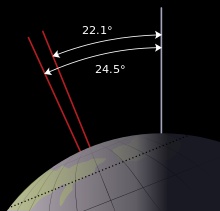
The angle of the Earth's axial tilt with respect to the orbital plane (the obliquity of theecliptic) varies between 22.1° and 24.5°, over a cycle of about 41,000 years. The current tilt is 23.44°, roughly halfway between its extreme values. The tilt last reached its maximum in 8,700BCE,which correlates with the beginning of the Holocene, the current geological epoch. It is now in the decreasing phase of its cycle, and will reach its minimum around the year 11,800CE.[12]Increased tilt increases the amplitude of the seasonal cycle ininsolation,providing more solar radiation in each hemisphere's summer and less in winter. However, these effects are not uniform everywhere on the Earth's surface. Increased tilt increases the total annual solar radiation at higher latitudes, and decreases the total closer to the equator.[12]
The current trend of decreasing tilt, by itself, will promote milder seasons (warmer winters and colder summers), as well as an overall cooling trend.[12]Because most of the planet's snow and ice lies at high latitude,decreasingtilt may encourage the termination of aninterglacialperiod and the onset of aglacial periodfor two reasons: 1) there is less overall summer insolation, and 2) there is less insolation at higher latitudes (which melts less of the previous winter's snow and ice).[12]
Axial precession
[edit]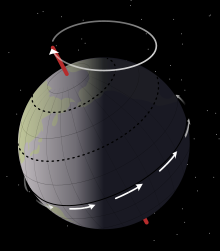
Axial precession is the trend in the direction of the Earth's axis of rotation relative to the fixed stars, with a period of about 25,700 years. Also known as the precession of the equinoxes, this motion means that eventuallyPolariswill no longer be the northpole star.This precession iscaused by the tidal forcesexerted by the Sun and the Moon on the rotating Earth; both contribute roughly equally to this effect.[citation needed]
Currently, perihelion occurs during the southern hemisphere's summer. This means that solar radiation due to both the axial tilt inclining the southern hemisphere toward the Sun, and the Earth's proximity to the Sun, will reach maximum during the southern summer and reach minimum during the southern winter. These effects on heating are thus additive, which means that seasonal variation in irradiation of the southern hemisphere is more extreme. In the northern hemisphere, these two factors reach maximum at opposite times of the year: the north is tilted toward the Sun when the Earth is furthest from the Sun. The two effects work in opposite directions, resulting in less extreme variations in insolation.
In about 10,000 years, the north pole will be tilted toward the Sun when the Earth is at perihelion. Axial tilt and orbital eccentricity will both contribute their maximum increase in solar radiation during the northern hemisphere's summer. Axial precession will promote more extreme variation in irradiation of the northern hemisphere and less extreme variation in the south. When the Earth's axis is aligned such that aphelion and perihelion occur near the equinoxes, axial tilt will not be aligned with or against eccentricity.[citation needed]
Apsidal precession
[edit]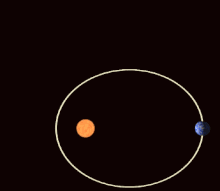
The orbital ellipse itself precesses in space, in an irregular fashion, completing a full cycle in about 112,000 years relative to the fixed stars.[13]Apsidal precession occurs in the plane of the ecliptic and alters the orientation of the Earth's orbit relative to the ecliptic. This happens primarily as a result of interactions with Jupiter and Saturn. Smaller contributions are also made by the sun's oblateness and by the effects ofgeneral relativitythat are well known for Mercury.[14]
Apsidal precession combines with the 25,700-year cycle of axial precession (seeabove) to vary the position in the year that the Earth reaches perihelion. Apsidal precession shortens this period to about 21,000 years, at present. According to a relatively old source (1965), the average value over the last 300,000 years was 23,000 years, varying between 20,800 and 29,000 years.[13]

As the orientation of Earth's orbit changes, each season will gradually start earlier in the year. Precession means the Earth's nonuniform motion (seeabove) will affect different seasons. Winter, for instance, will be in a different section of the orbit. When the Earth's apsides (extremes of distance from the sun) are aligned with the equinoxes, the length of spring and summer combined will equal that of autumn and winter. When they are aligned with the solstices, the difference in the length of these seasons will be greatest.[citation needed]
Orbital inclination
[edit]
The inclination of Earth's orbit drifts up and down relative to its present orbit. This three-dimensional movement is known as "precession of the ecliptic" or "planetary precession". Earth's current inclination relative to theinvariable plane(the plane that represents theangular momentumof the Solar System—approximately the orbital plane of Jupiter) is 1.57°.[citation needed]Milankovitch did not study planetary precession. It was discovered more recently and measured, relative to Earth's orbit, to have a period of about 70,000 years. When measured independently of Earth's orbit, but relative to the invariable plane, however, precession has a period of about 100,000 years. This period is very similar to the 100,000-year eccentricity period. Both periods closely match the 100,000-year pattern of glacial events.[15]
Theory constraints
[edit]
Materials taken from the Earth have been studied to infer the cycles of past climate. Antarctic ice cores contain trapped air bubbles whose ratios of different oxygen isotopes are a reliableproxyfor global temperatures around the time the ice was formed. Study of this data concluded that the climatic response documented in the ice cores was driven by northern hemisphere insolation as proposed by the Milankovitch hypothesis.[16]Similar astronomical hypotheses had been advanced in the 19th century byJoseph Adhemar,James Croll,and others.[17]
Analysis of deep-ocean cores and of lake depths,[18][19]and a seminal paper byHays,Imbrie,andShackleton[20]provide additional validation through physical evidence. Climate records contained in a 1,700 ft (520 m) core of rock drilled in Arizona show a pattern synchronized with Earth's eccentricity, and cores drilled in New England match it, going back 215 million years.[21]
100,000-year issue
[edit]Of all the orbital cycles, Milankovitch believed that obliquity had the greatest effect on climate, and that it did so by varying the summer insolation in northern high latitudes. Therefore, he deduced a 41,000-year period for ice ages.[22][23]However, subsequent research[20][24][25]has shown thatice agecycles of theQuaternary glaciationover the last million years have been at a period of 100,000 years, which matches the eccentricity cycle. Various explanations for this discrepancy have been proposed, includingfrequency modulation[26]or various feedbacks (fromcarbon dioxide,orice sheet dynamics). Some models can reproduce the 100,000-year cycles as a result of non-linear interactions between small changes in the Earth's orbit and internal oscillations of the climate system.[27][28]In particular, the mechanism of thestochastic resonancewas originally proposed in order to describe this interaction.[29][30]
Jung-Eun Lee of Brown University proposes that precession changes the amount of energy that Earth absorbs, because the southern hemisphere's greater ability to grow sea ice reflects more energy away from Earth. Moreover, Lee says, "Precession only matters when eccentricity is large. That's why we see a stronger 100,000-year pace than a 21,000-year pace."[31][32]Some others have argued that the length of the climate record is insufficient to establish a statistically significant relationship between climate and eccentricity variations.[33]
Transition changes
[edit]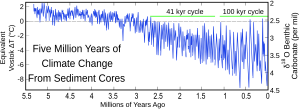

From 1–3 million years ago, climate cycles matched the 41,000-year cycle in obliquity. After one million years ago, theMid-Pleistocene Transition(MPT) occurred with a switch to the 100,000-year cycle matching eccentricity. Thetransition problemrefers to the need to explain what changed one million years ago.[34]The MPT can now be reproduced in numerical simulations that include a decreasing trend incarbon dioxideand glacially induced removal ofregolith.[35]
Interpretation of unsplit peak variances
[edit]Even the well-dated climate records of the last million years do not exactly match the shape of the eccentricity curve. Eccentricity has component cycles of 95,000 and 125,000 years. Some researchers, however, say the records do not show these peaks, but only indicate a single cycle of 100,000 years.[36]The split between the two eccentricity components, however, is observed at least once in a drill core from the 500-million year-old Scandinavian Alum Shale.[37]
Unsynced stage five observation
[edit]Deep-sea core samples show that the interglacial interval known asmarine isotope stage 5began 130,000 years ago. This is 10,000 years before the solar forcing that the Milankovitch hypothesis predicts. (This is also known as the causality problem because the effect precedes the putative cause.)[38]
Present and future conditions
[edit]
Since orbital variations are predictable,[39]any model that relates orbital variations to climate can be run forward to predict future climate, with two caveats: the mechanism by whichorbital forcinginfluences climate is not definitive; and non-orbital effects can be important (for example, thehuman impact on the environmentprincipally increasesgreenhouse gasesresulting ina warmer climate[40][41][42]).
An often-cited 1980 orbital model byImbriepredicted "the long-term cooling trend that began some 6,000 years ago will continue for the next 23,000 years."[43]Another work[44]suggests thatsolar insolationat 65° N will reach a peak of 460 W·m−2in around 6,500 years, before decreasing back to current levels (450 W·m−2)[45]in around 16,000 years. Earth's orbit will become less eccentric for about the next 100,000 years, so changes in this insolation will be dominated by changes in obliquity, and should not decline enough to permit anew glacial periodin the next 50,000 years.[46][47]
Other celestial bodies
[edit]Mars
[edit]Since 1972, speculation sought a relationship between the formation of Mars' alternating bright and dark layers in the polar layered deposits, and the planet's orbital climate forcing. In 2002, Laska, Levard, and Mustard showed ice-layer radiance, as a function of depth, correlate with the insolation variations in summer at the Martian north pole, similar to palaeoclimate variations on Earth. They also showed Mars' precession had a period of about 51kyr,obliquity had a period of about 120 kyr, and eccentricity had a period ranging between 95 and 99 kyr. In 2003, Head, Mustard, Kreslavsky, Milliken, and Marchant proposed Mars was in an interglacial period for the past 400 kyr, and in a glacial period between 400 and 2100 kyr, due to Mars' obliquity exceeding 30°. At this extreme obliquity, insolation is dominated by the regular periodicity of Mars' obliquity variation.[48][49]Fourier analysisof Mars' orbital elements, show an obliquity period of 128 kyr, and a precession index period of 73 kyr.[50][51]
Marshas no moon large enough to stabilize its obliquity, which has varied from 10 to 70 degrees. This would explain recent observations of its surface compared to evidence of different conditions in its past, such as the extent of itspolar caps.[52][53]
Outer Solar system
[edit]Saturn's moonTitanhas a cycle of approximately 60,000 years that could change the location of themethanelakes.[54]Neptune's moonTritonhas a variation similar to Titan's, which could cause its solidnitrogendeposits to migrate over long time scales.[55]
Exoplanets
[edit]Scientists using computer models to study extreme axial tilts have concluded that high obliquity could cause extreme climate variations, and while that would probably not render a planet uninhabitable, it could pose difficulty for land-based life in affected areas. Most such planets would nevertheless allow development of both simple and more complex lifeforms.[56]Although the obliquity they studied is more extreme than Earth ever experiences, there are scenarios 1.5 to 4.5 billion years from now, as the Moon's stabilizing effect lessens, where obliquity could leave its current range and the poles could eventually point almost directly at the Sun.[57]
See also
[edit]References
[edit]- ^Kerr, Richard A. (14 July 1978)."Climate Control: How Large a Role for Orbital Variations?".Science.201(4351): 144–146.Bibcode:1978Sci...201..144K.doi:10.1126/science.201.4351.144.JSTOR1746691.PMID17801827.Retrieved29 July2022.
- ^Buis, Alan (27 February 2020)."Why Milankovitch (Orbital) Cycles Can't Explain Earth's Current Warming".NASA.Retrieved29 July2022.
- ^Girkin AM (2005).A Computational Study on the Evolution of the Dynamics of the Obliquity of the Earth(Master of Science thesis). Miami University. Archived fromthe original(PDF)on 30 September 2014.
- ^G. K. Gilbert(February–March 1895). "Sedimentary Measurement of Cretaceous Time".The Journal of Geology.3(2).University of Chicago Press:121–127.Bibcode:1895JG......3..121G.doi:10.1086/607150.JSTOR30054556.S2CID129629329.
As the earth's axis slowly describes its circle on the celestial sphere the relation of the seasons to perihelion is steadily shifted.
Note: It is intuitive that if equinoxes and solstices occur in shifting positions on an eccentric orbit, then these astronomical seasons must occur at shifting proximities; and as either eccentricity and tilt vary, the intensities of the effects of these shifts also vary.'l - ^Abu-Hamdeh (2020)."Thermal Properties of Soils as affected by Density and Water Content".Biosystems Engineering.86(1): 97–102.doi:10.1016/S1537-5110(03)00112-0.Retrieved16 May2021.
Volumetric heat capacity ranged from 1.48 to 3.54 MJ/m3/°C for clay and from 1.09 to 3.04 MJ/m3/°C for sand at moisture contents from 0 to 0·25 (kg/kg) [etc.]
Note: SeeTable of specific heat capacities;water is about 4.2 MJ/m3/°C. - ^abLaskar J, Fienga A, Gastineau M, Manche H (2011)."La2010: A New Orbital Solution for the Long-term Motion of the Earth"(PDF).Astronomy & Astrophysics.532(A889): A89.arXiv:1103.1084.Bibcode:2011A&A...532A..89L.doi:10.1051/0004-6361/201116836.S2CID10990456.See specificallythe downloadable data file.
- ^abcLaskar2020
- ^Berger A, Loutre MF, Mélice JL (2006)."Equatorial insolation: from precession harmonics to eccentricity frequencies"(PDF).Climate of the Past Discussions.2(4): 519–533.doi:10.5194/cpd-2-519-2006.
- ^Buis, Alan (27 February 2020)."Milankovitch (Orbital) Cycles and Their Role in Earth's Climate".NASA's Jet Propulsion Laboratory.Retrieved8 January2024.
- ^Buis, Alan (27 February 2020)."Milankovitch (Orbital) Cycles and Their Role in Earth's Climate".NASA's Jet Propulsion Laboratory.Retrieved8 January2024.
- ^Data fromUnited States Naval ObservatoryArchived13 October 2007 at theWayback Machine
- ^abcdefgBuis, Alan;Jet Propulsion Laboratory(27 February 2020)."Milankovitch (Orbital) Cycles and Their Role in Earth's Climate".climate.nasa.gov.NASA.Retrieved10 May2021.
Over the last million years, it has varied between 22.1 and 24.5 degrees.... The greater Earth's axial tilt angle, the more extreme our seasons are.... Larger tilt angles favor periods of deglaciation (the melting and retreat of glaciers and ice sheets). These effects aren't uniform globally – higher latitudes receive a larger change in total solar radiation than areas closer to the equator.... Earth's axis is currently tilted 23.4 degrees,... As ice cover increases, it reflects more of the Sun's energy back into space, promoting even further cooling.
Note: SeeAxial tilt.Zero obliquity results in minimum (zero) continuous insolation at the poles and maximum continuous insolation at the equator. Any increase of obliquity (to 90 degrees) causes seasonal increase of insolation at the poles and causes decrease of insolation at the equator on any day of the year except anequinox. - ^abvan den Heuvel EP (1966)."On the Precession as a Cause of Pleistocene Variations of the Atlantic Ocean Water Temperatures".Geophysical Journal International.11(3): 323–336.Bibcode:1966GeoJ...11..323V.doi:10.1111/j.1365-246X.1966.tb03086.x.Note: The reader may question the number and precision of the periods which the author reports in this early paper.
- ^Barbieri, L.; Talamucci, F. (20 February 2018). "Calculation of Apsidal Precession via Perturbation Theory".Advances in Astrophysics.4(3).arXiv:1802.07115.doi:10.22606/adap.2019.43003.S2CID67784452.
- ^Muller RA, MacDonald GJ (August 1997)."Spectrum of 100-kyr glacial cycle: orbital inclination, not eccentricity".Proceedings of the National Academy of Sciences of the United States of America.94(16): 8329–34.Bibcode:1997PNAS...94.8329M.doi:10.1073/pnas.94.16.8329.PMC33747.PMID11607741.
- ^Kawamura K, Parrenin F, Lisiecki L, Uemura R, Vimeux F, Severinghaus JP, et al. (August 2007). "Northern Hemisphere forcing of climatic cycles in Antarctica over the past 360,000 years".Nature.448(7156): 912–6.Bibcode:2007Natur.448..912K.doi:10.1038/nature06015.PMID17713531.S2CID1784780.
- ^Imbrie, John; Imbrie, Katherine Palmer (1979).Ice Ages.London: Macmillan Education UK.doi:10.1007/978-1-349-04699-7(inactive 29 July 2024).ISBN978-1-349-04701-7.
{{cite book}}:CS1 maint: DOI inactive as of July 2024 (link) - ^Kerr RA (February 1987). "Milankovitch Climate Cycles Through the Ages: Earth's orbital variations that bring on ice ages have been modulating climate for hundreds of millions of years".Science.235(4792): 973–4.Bibcode:1987Sci...235..973K.doi:10.1126/science.235.4792.973.JSTOR1698758.PMID17782244./O
- ^Olsen PE (November 1986). "A 40-million-year lake record of early mesozoic orbital climatic forcing".Science.234(4778): 842–8.Bibcode:1986Sci...234..842O.doi:10.1126/science.234.4778.842.JSTOR1698087.PMID17758107.S2CID37659044.
- ^abHays JD,Imbrie J,Shackleton NJ(December 1976). "Variations in the Earth's Orbit: Pacemaker of the Ice Ages".Science.194(4270): 1121–32.Bibcode:1976Sci...194.1121H.doi:10.1126/science.194.4270.1121.PMID17790893.S2CID667291.
- ^Bakalar N (21 May 2018)."Every 202,500 Years, Earth Wanders in a New Direction".The New York Times.Retrieved25 May2018.
- ^Milankovitch M (1998) [1941].Canon of Insolation and the Ice Age Problem.Belgrade: Zavod za Udz̆benike i Nastavna Sredstva.ISBN978-86-17-06619-0.;see also"Astronomical Theory of Climate Change".
- ^Imbrie J, Imbrie KP (1986).Ice Ages: Solving the Mystery.Harvard University Press. p. 158.ISBN978-0-674-44075-3.
- ^Shackleton NJ, Berger A,Peltier WR(3 November 2011). "An alternative astronomical calibration of the lower Pleistocene timescale based on ODP Site 677".Transactions of the Royal Society of Edinburgh: Earth Sciences.81(4): 251–261.doi:10.1017/S0263593300020782.S2CID129842704.
- ^Abe-Ouchi A, Saito F, Kawamura K, Raymo ME, Okuno J, Takahashi K, Blatter H (August 2013)."Insolation-driven 100,000-year glacial cycles and hysteresis of ice-sheet volume".Nature.500(7461): 190–3.Bibcode:2013Natur.500..190A.doi:10.1038/nature12374.PMID23925242.S2CID4408240.
- ^Rial JA (October 2003),"Earth's orbital Eccentricity and the rhythm of the Pleistocene ice ages: the concealed pacemaker"(PDF),Global and Planetary Change,41(2): 81–93,Bibcode:2004GPC....41...81R,doi:10.1016/j.gloplacha.2003.10.003,archived fromthe original(PDF)on 20 July 2011
- ^Ghil M(1994). "Cryothermodynamics: the chaotic dynamics of paleoclimate".Physica D.77(1–3): 130–159.Bibcode:1994PhyD...77..130G.doi:10.1016/0167-2789(94)90131-7.
- ^Gildor H, Tziperman E (2000)."Sea ice as the glacial cycles' climate switch: Role of seasonal and orbital forcing".Paleoceanography.15(6): 605–615.Bibcode:2000PalOc..15..605G.doi:10.1029/1999PA000461.
- ^Benzi, R; Sutera, A; Vulpiani, A (1 November 1981)."The mechanism of stochastic resonance".Journal of Physics A: Mathematical and General.14(11): L453–L457.Bibcode:1981JPhA...14L.453B.doi:10.1088/0305-4470/14/11/006.ISSN0305-4470.S2CID123005407.
- ^Benzi, Roberto;Parisi, Giorgio;Sutera, Alfonso; Vulpiani, Angelo (February 1982)."Stochastic resonance in climatic change".Tellus.34(1): 10–16.Bibcode:1982Tell...34...10B.doi:10.1111/j.2153-3490.1982.tb01787.x.
- ^Stacey K (26 January 2017)."Earth's orbital variations and sea ice synch glacial periods".m.phys.org.
- ^Lee JE, Shen A, Fox-Kemper B, Ming Y (1 January 2017)."Hemispheric sea ice distribution sets the glacial tempo".Geophys. Res. Lett.44(2): 1008–1014.Bibcode:2017GeoRL..44.1008L.doi:10.1002/2016GL071307.
- ^Wunsch C (2004)."Quantitative estimate of the Milankovitch-forced contribution to observed Quaternary climate change".Quaternary Science Reviews.23(9–10): 1001–12.Bibcode:2004QSRv...23.1001W.doi:10.1016/j.quascirev.2004.02.014.
- ^Zachos JC, Shackleton NJ, Revenaugh JS, Pälike H, Flower BP (April 2001)."Climate response to orbital forcing across the Oligocene-Miocene boundary".Science.292(5515): 274–8.Bibcode:2001Sci...292..274Z.doi:10.1126/science.1058288.PMID11303100.S2CID38231747.Archived fromthe originalon 3 December 2017.Retrieved24 October2010.
- ^Willeit M, Ganopolski A, Calov R, Brovkin V (April 2019)."Mid-Pleistocene transition in glacial cycles explained by declining CO2and regolith removal ".Science Advances.5(4): eaav7337.Bibcode:2019SciA....5.7337W.doi:10.1126/sciadv.aav7337.PMC6447376.PMID30949580.
- ^"Nonlinear coupling between 100 ka periodicity of the paleoclimate records in loess and periodicities of precession and semi-precession"(PDF)– via ProQuest.
- ^Sørensen, A.L., Nielsen, A.T., Thibault, N., Zhao, Z., Schovsbo, N.H., Dahl, T.W., 2020. Astronomically forced climate change in the late Cambrian. Earth Planet. Sci. Lett. 548, 116475.https://doi.org/10.1016/j.epsl.2020.116475
- ^Karner DB, Muller RA (June 2000). "PALEOCLIMATE: A Causality Problem for Milankovitch".Science.288(5474): 2143–4.doi:10.1126/science.288.5474.2143.PMID17758906.S2CID9873679.
- ^Varadi F, Runnegar B,Ghil M(2003)."Successive Refinements in Long-Term Integrations of Planetary Orbits".The Astrophysical Journal.592(1): 620–630.Bibcode:2003ApJ...592..620V.doi:10.1086/375560.
- ^Kaufman DS, Schneider DP, McKay NP, Ammann CM, Bradley RS, Briffa KR, et al. (September 2009). "Recent warming reverses long-term arctic cooling".Science.325(5945): 1236–9.Bibcode:2009Sci...325.1236K.CiteSeerX10.1.1.397.8778.doi:10.1126/science.1173983.PMID19729653.S2CID23844037.
- ^"Arctic Warming Overtakes 2,000 Years of Natural Cooling".UCAR. 3 September 2009. Archived fromthe originalon 27 April 2011.Retrieved19 May2011.
- ^Bello D (4 September 2009)."Global Warming Reverses Long-Term Arctic Cooling".Scientific American.Retrieved19 May2011.
- ^Imbrie J, Imbrie JZ (February 1980). "Modeling the climatic response to orbital variations".Science.207(4434): 943–53.Bibcode:1980Sci...207..943I.doi:10.1126/science.207.4434.943.PMID17830447.S2CID7317540.
- ^Mukherjee, Pami; Sinha, Nitesh; Chakraborty, Supriyo (10 July 2017)."Investigating the dynamical behavior of the Intertropical Convergence Zone since the last glacial maximum based on terrestrial and marine sedimentary records".Quaternary International.Third Pole: The Last 20,000 Years - Part 1.443:49–57.Bibcode:2017QuInt.443...49M.doi:10.1016/j.quaint.2016.08.030.ISSN1040-6182.
- ^"Energy resources: solar energy".Energy resources: solar energy.Retrieved17 June2023.[permanent dead link]
- ^Berger A, Loutre MF (August 2002). "Climate. An exceptionally long interglacial ahead?".Science.297(5585): 1287–8.doi:10.1126/science.1076120.PMID12193773.S2CID128923481.
- ^Ganopolski A,Winkelmann R,Schellnhuber HJ (January 2016). "Critical insolation-CO2 relation for diagnosing past and future glacial inception".Nature.529(7585): 200–3.Bibcode:2016Natur.529..200G.doi:10.1038/nature16494.PMID26762457.S2CID4466220.
- ^Laskar J, Levrard B,Mustard JF(September 2002)."Orbital forcing of the martian polar layered deposits"(PDF).Nature.419(6905): 375–7.Bibcode:2002Natur.419..375L.doi:10.1038/nature01066.PMID12353029.S2CID4380705.Archived fromthe original(PDF)on 19 July 2011.Retrieved11 December2020.
- ^Head JW, Mustard JF, Kreslavsky MA, Milliken RE, Marchant DR (December 2003)."Recent ice ages on Mars"(PDF).Nature.426(6968): 797–802.Bibcode:2003Natur.426..797H.doi:10.1038/nature02114.PMID14685228.S2CID2355534.
- ^Brzostowski M (2004). "Martian Milankovic Cycles, a Constraint for Understanding Martian Geology?".Western Pacific Geophysics Meeting, Supplement to Eos, Transactions, American Geophysical Union.85(28): WP11.
- ^Brzostowski M (2020)."Milankovic Cycles on Mars and the Impact on Economic Exploration".ACE 2020.American Association of Petroleum Geologists.Retrieved11 December2020.
- ^Schorghofer N (2008). "Temperature response of Mars to Milankovitch cycles".Geophysical Research Letters.35(18): L18201.Bibcode:2008GeoRL..3518201S.doi:10.1029/2008GL034954.S2CID16598911.
- ^"3.5 Modeling Milankovitch cycles on Mars (2010 – 90; Annual Symp Planet Atmos)".Confex.
- ^Wethington, Nicholos (30 November 2009)."Lake Asymmetry on Titan Explained".
- ^"Sun Blamed for Warming of Earth and Other Worlds".LiveScience.com.12 March 2007.
- ^Williams DM, Pollard P (2002)."Earth-like worlds on eccentric orbits: excursions beyond the habitable zone"(PDF).Inter. J. Astrobio.1(1): 21–9.Bibcode:2002IJAsB...1...61W.doi:10.1017/s1473550402001064.S2CID37593615.Archived fromthe original(PDF)on 22 August 2013.Retrieved17 September2009.
- ^Neron de Surgy O, Laskar J (February 1997). "On the long term evolution of the spin of the Earth".Astronomy and Astrophysics.318:975–989.Bibcode:1997A&A...318..975N.
Bibliography
[edit]- Edvardsson S, Karlsson KG, Engholm M (2002)."Accurate spin axes and solar system dynamics: Climatic variations for the Earth and Mars".Astronomy and Astrophysics.384(2): 689–701.Bibcode:2002A&A...384..689E.doi:10.1051/0004-6361:20020029.This is the first work that investigated the derivative of the ice volume in relation to insolation (page 698).
- In Ancient Rocks Scientists See a Climate Cycle Working Across Deep Time (Columbia Climate School, Kevin Krajick, May 7, 2018)
- Kaufmann RK, Juselius K (2016)."Testing competing forms of the Milankovitch hypothesis".Paleoceanography.31(2): 286–297.Bibcode:2016PalOc..31..286K.doi:10.1002/2014PA002767..
- Pälike H, Norris RD, Herrle JO, Wilson PA, Coxall HK, Lear CH, et al. (December 2006)."The heartbeat of the Oligocene climate system"(PDF).Science.314(5807): 1894–8.Bibcode:2006Sci...314.1894P.doi:10.1126/science.1133822.PMID17185595.S2CID32334205.
A 13-million-year continuous record ofOligoceneclimate from the equatorial Pacific reveals a pronounced "heartbeat" in the global carbon cycle and periodicity of glaciations.
- Roe G (2006)."In defense of Milankovitch".Geophysical Research Letters.33(24): L24703.Bibcode:2006GeoRL..3324703R.doi:10.1029/2006GL027817.S2CID13230658.This shows that Milankovitch theory fits the data extremely well, over the past million years, provided that we consider derivatives.
- The oldest reference for Milankovitch cycles is:Milankovitch M (1930).Mathematische Klimalehre und Astronomische Theorie der Klimaschwankungen.Handbuch der Klimatologie. Vol. 1 Teil A. von Gebrüder Borntraeger.OCLC490063906.
- Tying celestial mechanics to Earth's ice age (Physics Today 73 (5), Maslin M. A. 01 May 2020)
- Zachos J, Pagani M, Sloan L, Thomas E, Billups K (April 2001)."Trends, rhythms, and aberrations in global climate 65 Ma to present"(PDF).Science.292(5517): 686–93.Bibcode:2001Sci...292..686Z.doi:10.1126/science.1059412.PMID11326091.S2CID2365991.
This review article discusses cycles and great-scale changes in the global climate during theCenozoicEra.
External links
[edit]![]() Media related toMilankovitch cyclesat Wikimedia Commons
Media related toMilankovitch cyclesat Wikimedia Commons
![]() Milankovitch cyclesat Wikibooks
Milankovitch cyclesat Wikibooks
- Campisano, C. J. (2012)Milankovitch Cycles, Paleoclimatic Change, and Hominin Evolution.Nature Education Knowledge 4(3):5
- Ice Age – Milankovitch Cycles – National Geographic Channel
- The Milankovitch band,Internet Archive ofAmerican Geophysical Unionlecture


